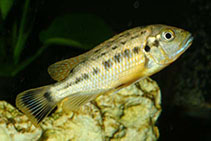| Family: |
Cichlidae (Cichlids), subfamily: Pseudocrenilabrinae |
| Max. size: |
16.5 cm TL (male/unsexed) |
| Environment: |
benthopelagic; freshwater; pH range: 7.80000019073486 - 8.30000019073486; dH range: 10 - 20 |
| Distribution: |
Africa: Endemic to Lake Malawi. Occurs in Deep Bay, Vua, Nkhata Bay; Likoma, Chisumulu, Mbenji and Maleri Islands; the southeast arm of the lake. |
| Diagnosis: |
Dorsal spines (total): 17-17; Dorsal soft rays (total): 8-8; Anal spines: 3-3; Anal soft rays: 8-8. No acutely sloped ethmovomerine block. Lower jaw parallel to a line from the tip of the snout to the hypural plate. Head depth 102% HL); eyes large, vertical eye diameter 25.5% (Ref. 41512). |
| Biology: |
Occurs in very shallow rocky biotopes, usually at exposed sites. Mostly found in the upper 2 m. Feeds mainly from the water column; on plankton when this is available and on insect larvae and other invertebrates that appear in the open water. Has also been observed feeding from the biocover on the rocks (Ref. 5595). |
| IUCN Red List Status: |
Near Threatened (NT); Date assessed: 19 June 2018 (B1a) Ref. (130435)
|
| Threat to humans: |
harmless |
Source and more info: www.fishbase.org. For personal, classroom, and other internal use only. Not for publication.

